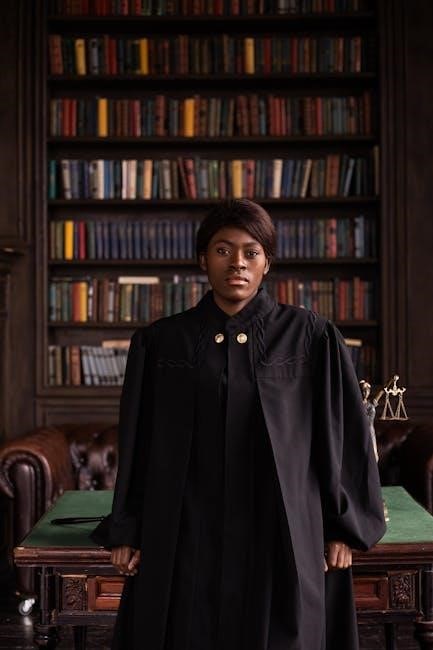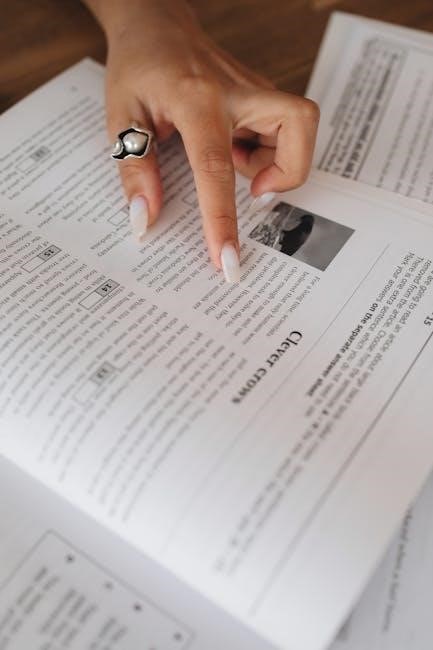The act opens with ongoing witchcraft accusations, as Reverend Hale investigates the Proctor household, uncovering tension and internal conflicts. Mary Warren’s revelation about the trials escalates the drama.
1.1 Setting and Initial Tension
Act 2 opens in the Proctor household, where the cold, tense atmosphere mirrors the emotional distance between John and Elizabeth. The setting reflects their strained relationship, heightened by John’s past affair with Abigail. Mary Warren’s nervous presence and the arrival of Reverend Hale intensify the tension, as the fear of witchcraft accusations looms, creating an undercurrent of dread and mistrust.
1.2 The Arrival of Reverend Hale
Reverend Hale’s arrival at the Proctor home introduces a sense of authority and scrutiny. He questions the family’s Christian practices, particularly their absence from church and the unbaptized children. Hale’s inquiries, while seemingly routine, carry an underlying threat, as he seeks evidence of witchcraft. His presence escalates the tension, highlighting the community’s paranoia and the dangerous intersection of religion and fear.
1.3 The Escalation of Accusations
The accusations intensify as Mary Warren reveals that Sarah Good attempted to kill her, spreading fear and distrust. Abigail’s influence grows, manipulating the court with false claims. Respectable women are falsely accused, and the hysteria escalates, with even Proctor’s wife, Elizabeth, becoming a target. The community’s panic deepens, fueled by lies and unchecked fear, leading to a spiraling crisis.
1.4 Climax: Mary Warren’s Revelation
Mary Warren’s testimony exposes the falsity of the accusations, revealing that the girls fabricated their claims. She admits to lying about Sarah Good and the “yellow bird,” fearing Abigail’s retaliation. Her courage momentarily shifts the trial’s momentum, but her fear ultimately leads to her recantation, further entangling John Proctor in the witchcraft allegations and escalating the dramatic tension.
Themes in Act 2
The act explores themes of public versus private life, the ambiguity of evidence, guilt, and redemption, highlighting the moral and societal conflicts driving the witch trials.
2.1 The Line Between Public and Private Life
The act highlights the tension between public reputation and private morality, as characters like John and Elizabeth Proctor struggle with societal expectations. Reverend Hale’s investigation intrudes on their private lives, forcing them to confront moral dilemmas publicly. This theme underscores the pressure to maintain a virtuous public image, even as personal integrity is tested by fear and accusation.
2.2 The Ambiguity of Evidence
The act illustrates how ambiguous evidence fuels the witch trials. Mary Warren’s claims and spectral visions are accepted without concrete proof, while genuine doubts are dismissed. This ambiguity highlights the dangerous reliance on unverifiable testimony, as fear and superstition override rational judgment, leading to unjust condemnations and the erosion of trust in the community.
2.3 Guilt and Redemption
John Proctor’s guilt over his affair with Abigail haunts him, while Elizabeth’s distrust deepens his internal turmoil. Mary Warren’s fear-driven lies and eventual courage to reveal the truth showcase her struggle for redemption. Reverend Hale’s growing doubt in the trials reflects his own moral conflict, as he seeks to salvage his integrity amid the chaos, highlighting the complexity of guilt and the pursuit of redemption.

Character Analysis
Act 2 delves into the complexities of John Proctor, Elizabeth, Mary Warren, and Reverend Hale, exploring their internal struggles, moral dilemmas, and evolving beliefs amidst the witch trials;
3.1 John Proctor: Internal Conflict and Integrity
John Proctor grapples with guilt over his affair with Abigail, which strains his relationship with Elizabeth. His internal conflict deepens as he confronts the hypocrisy of the witch trials, revealing his moral integrity. Proctor’s admission of his affair to Reverend Hale showcases his commitment to truth, even at great personal cost, highlighting his struggle to maintain dignity amidst societal chaos and personal turmoil.
3.2 Elizabeth Proctor: Distrust and Forgiveness
Elizabeth Proctor’s relationship with John is marked by distrust due to his past affair with Abigail. Her cold demeanor reflects her lingering hurt, yet she shows signs of forgiveness. Elizabeth’s suggestion that John go to Salem to clear their names highlights her desire for truth and redemption, balancing her pain with a deep-seated love and loyalty to her husband.
3.3 Mary Warren: Fear and Betrayal
Mary Warren, the Proctors’ servant, is consumed by fear and guilt. Her decision to reveal information about Sarah Good and her own experiences with witchcraft reflects her internal turmoil. Despite her loyalty to the Proctors, her fear of Abigail and the trials leads her to betray their trust, highlighting her vulnerability and the overwhelming pressure of the witch hunt.
3.4 Reverend Hale: Zeal and Doubt
Reverend Hale enters Act 2 with unwavering confidence in his mission to root out witchcraft, but his certainty gradually falters as he witnesses the chaos and manipulation. His questioning of the Proctors reveals his growing doubt about the trials’ legitimacy. Hale’s internal conflict intensifies as he grapples with the moral implications of his role, highlighting his struggle between zeal for justice and the corruption of the court.

Symbols and Motifs
The Proctor’s home symbolizes marital strife, while the Bible represents religious authority. Fire imagery signifies both purification and destruction, reflecting the chaos of the witch trials.
4.1 The Proctor’s Home as a Symbol of Strife
The Proctor’s home in The Crucible Act 2 symbolizes the internal and external turmoil faced by the family. John and Elizabeth’s strained relationship, amplified by John’s past affair with Abigail, creates a tense atmosphere. The arrival of Reverend Hale and Mary Warren’s revelations about the trials further escalate the conflict, mirroring the chaotic witch hunt outside. The home becomes a battleground for truth, guilt, and redemption.
4.2 The Bible and Religious Authority
The Bible in The Crucible Act 2 represents religious authority and moral guidance. Reverend Hale uses it to investigate and judge, emphasizing its role in shaping Salem’s rigid society. However, the misuse of religious texts to justify false accusations reveals the corruption of divine authority, highlighting the tension between genuine faith and its exploitation for power and control.
4.3 The Fire as a Symbol of Purification and Destruction
The fire in The Crucible Act 2 symbolizes both purification and destruction, reflecting the duality of its role in the play. It represents the Puritan belief in cleansing sin, yet also the destructive chaos of the witch trials. Fire imagery underscores the escalating fear and hysteria, as well as the moral and societal combustion caused by false accusations and unchecked paranoia, highlighting its dual significance in the dramatic tension.

Quote Analysis
Key quotes in Act 2 reveal character motivations and thematic depth. John Proctor’s “It is winter in here yet” highlights the emotional coldness in his home, while Elizabeth’s “I do think I see some shadow of guilt” reflects her lingering distrust. These quotes underscore the tension and moral conflict central to the act.
5.1 “It is winter in here yet” ⎼ John Proctor
John Proctor’s statement, “It is winter in here yet,” metaphorically describes the cold, tense atmosphere in his home. This line reflects his internal turmoil and strained relationship with Elizabeth, as well as the broader emotional chill caused by the witch trials and his own guilt. The quote underscores the themes of marital conflict and the oppressive mood permeating Salem society.
5.2 “I cannot judge you, John Proctor” ⎻ Reverend Hale
Reverend Hale’s statement reveals his internal conflict and growing doubt about the trials. While he initially supports the court’s authority, this line shows his hesitancy to condemn Proctor, hinting at his evolving perspective. The quote highlights Hale’s struggle between his religious duties and the moral ambiguity surrounding the witchcraft accusations, adding depth to his character development.
5.3 “I do think I see some shadow of guilt” ⎼ Elizabeth Proctor
Elizabeth’s statement reflects her lingering distrust of John, stemming from his past affair with Abigail. This quote captures the tension in their relationship, as Elizabeth struggles to reconcile her love for John with her suspicion of his moral failings. The line underscores the emotional strain and the complexity of their marriage, central to the act’s dramatic tension.

Historical Context
The Salem Witch Trials of 1692-1693 serve as the historical backdrop, highlighting mass hysteria, fear, and false accusations in a rigid, superstitious Puritan society, reflecting human nature.
6.1 The Salem Witch Trials
The Salem Witch Trials (1692-1693) were a series of prosecutions in colonial Massachusetts, fueled by mass hysteria and false accusations of witchcraft. The trials resulted in the executions of 20 people, most women, and the imprisonment of many others. They exposed deep-seated fears, superstition, and the dangers of unchecked power within a rigid, Puritan society. The event serves as a cautionary tale about fear, false accusations, and societal breakdown, reflecting themes central to The Crucible.
6.2 Puritan Values and Society
Puritan society emphasized strict moral codes, religious devotion, and community conformity. Fear of the unknown and rigid societal expectations fueled witchcraft accusations. The Puritans’ belief in a clear divide between good and evil led to extreme measures against perceived threats, creating an atmosphere of fear and mistrust that dominated Salem during the trials, as portrayed in The Crucible.
Study Questions
- How does John Proctor’s internal conflict reflect the broader societal tensions in Salem?
- What role does fear play in escalating the witchcraft accusations?
- Analyze the significance of Mary Warren’s testimony and its impact on the plot.
7.1 Comprehension Questions
- What news does Mary Warren reveal to John and Elizabeth about the trials?
- How does John Proctor know the witchcraft accusations are fraudulent?
- Why does Reverend Hale investigate the Proctor household?
- What does Elizabeth suggest to expose Abigail’s deception?
7.2 Thematic Questions
- How does fear drive the escalating accusations in Salem?
- In what ways does guilt shape John Proctor’s actions?
- What role does redemption play in the characters’ motivations?
- How does the theme of public vs. private life influence the plot?

Essay Topics
Analyze the role of fear in driving the witchcraft accusations. Discuss how lies and deception impact relationships and societal trust in Act 2.
8.1 The Role of Fear in Act 2
Fear is a pervasive force in Act 2, exploited by characters like Abigail to manipulate others and fuel the witchcraft hysteria. Proctor’s household becomes tense, with Elizabeth’s distrust of John and Mary Warren’s fear of Abigail. This fear isolates individuals, destroying trust and fostering a climate of suspicion. It drives the escalation of false accusations, as fear of retribution and societal condemnation leads to further betrayals and confessions.
In Act 2, lies and deception intensify the witch trials’ chaos. Abigail’s false accusations and Mary Warren’s pretend bewitchment exemplify how deceit spirals out of control. John Proctor’s past affair with Abigail, hidden yet revealed, further complicates trust. The Proctors’ household becomes a battleground of secrets, where lies lead to betrayal and moral decay, ultimately threatening the community’s stability. Key terms include “hysteria,” “irony,” and “imagery,” which highlight the play’s tension and moral conflict. These literary devices enhance the dramatic portrayal of deception and fear. – Hysteria: Mass panic and irrational fear driving the witch trials. Arthur Miller employs foreshadowing through Mary Warren’s revelations, hinting at the trials’ escalation. Imagery is used to depict the cold Proctor home, symbolizing emotional distance. Dramatic irony occurs as the audience knows Abigail’s manipulation, while characters remain unaware. Miller also uses symbolism, like the Bible, representing religious authority and moral judgment, to convey themes of guilt and redemption. These devices deepen the play’s tension and thematic complexity. Act 2 of The Crucible is pivotal, showcasing the escalation of hysteria and moral dilemmas. It highlights the breakdown of trust, the destructive power of fear, and the inevitable progression toward tragedy in Salem. Act 2 serves as the emotional and thematic core of The Crucible, deepening the exploration of hysteria, moral dilemmas, and personal integrity. It exposes the fragility of relationships and the destructive power of unchecked fear, setting the stage for the tragic events that unfold. The act highlights John Proctor’s internal conflict and the societal collapse, making it a pivotal moment in the play’s progression.8.2 The Impact of Lies and Deception
Vocabulary and Literary Terms
9.1 Key Vocabulary Definitions
– Irony: Abigail’s false accusations mirror her own guilt.
– Scapegoat: Innocent individuals blamed for societal sins.
– Deception: Lies fuel the trials, destroying trust and lives.
These terms highlight the play’s exploration of fear, guilt, and societal manipulation.9.2 Literary Devices in Act 2
Final Analysis
10.1 The Significance of Act 2 in the Play

